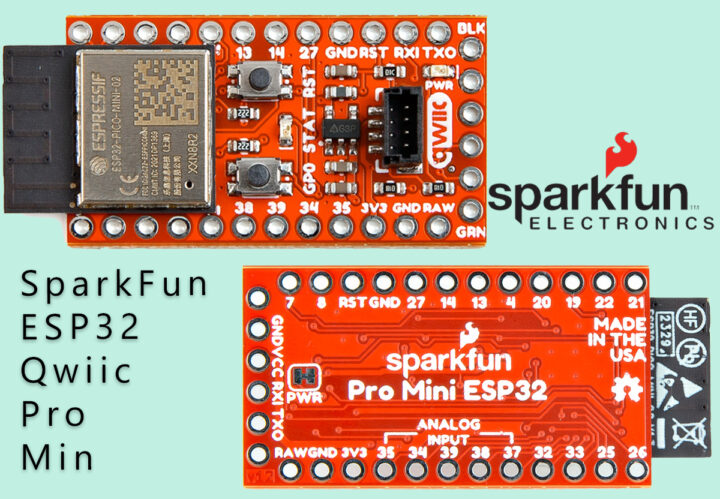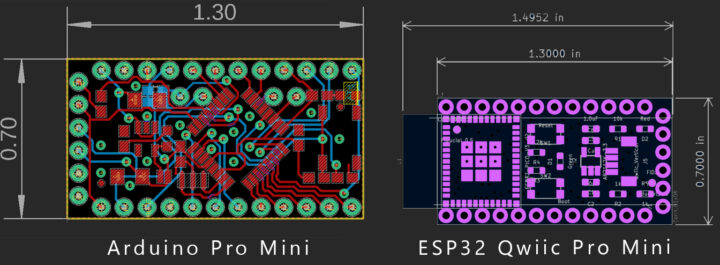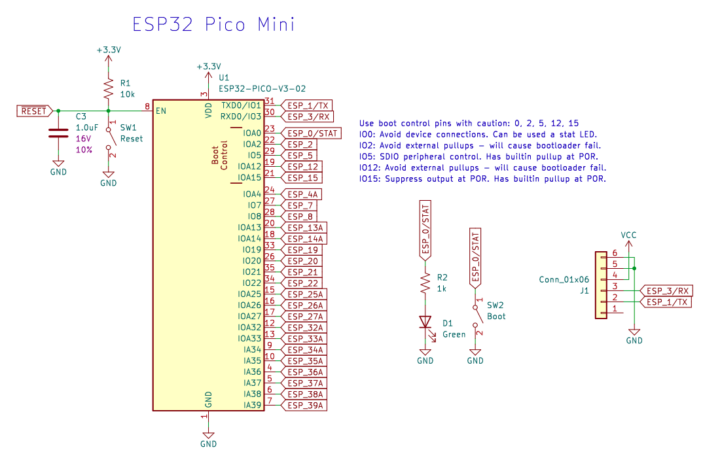SparkFun’s latest development board, the ESP32 Qwiic Pro Mini, puts the Espressif ESP32-PICO-MINI-02 on a compact Arduino Pro Mini footprint. It also includes an onboard QWICC connector for easy interfacing with a wide range of sensors and peripherals. We have already covered other Sparkfun dev boards like DataLogger IoT, Datalogger IoT – 9DoF, and SparkFun Thing Plus Matter you can check those out if interested.
Like any other ESP32 board, this also uses an ESP32 microcontroller which features a 32-bit dual-core processor, 520kB of SRAM, 2MB of PSRAM, 8MB of flash memory, and 16 kB of additional SRAM in its RTC. It supports Bluetooth 4.2 and BLE and has ADC and DAC, touch detection, PWM, TWAI, Ethernet MAC, UART, SPI, SDIO, I2C, and I2S interfaces.
As reported in a Hackster article, the board also features a Qwiic Connector for solderless connections to sensor boards and add-ons, positioned at a 90-degree angle for a compact footprint.
ESP32 Qwiic Pro Mini Technical Specifications:
- CPU and On-Chip Memory:
- Xtensa dual-core 32-bit LX6 microprocessor, up to 240 MHz.
- 448KB ROM, 520KB SRAM, 16KB SRAM in RTC.
- 8MB SPI flash, 2MB PSRAM.
- Wi-Fi:
- 802.11b/g/n, up to 150 Mbps.
- A-MPDU and A-MSDU aggregation, 0.4 µs guard interval.
- Operating channel frequency: 2412 ~ 2484 MHz.
- Bluetooth:
- Bluetooth V4.2 BR/EDR and LE.
- Class-1, class-2, class-3 transmitter, AFH, CVSD, SBC.
- Peripherals:
- UART, SPI, SDIO, I2C, LED PWM, Motor PWM, I2S, IR.
- Pulse counter, GPIO, capacitive touch sensor, ADC, DAC, TWAI®, Ethernet MAC.
- Integrated Components:
- 40 MHz crystal oscillator.
- ESP32-PICO-MINI-02: On-board PCB antenna.
- Operating Conditions:
- Voltage: 3.0 ~ 3.6 V.
- Temperature: –40 ~ 85 °C.
- 1x Vertical Qwiic Connector.
Despite all the known features, there are two key differences with this board: First, it doesn’t have an onboard USB-to-UART converter, so an external FTDI module is required. Second, it features a Qwiic connector for easy sensor and peripheral connections.
Next, I checked the dimensions of both boards. After seeing the board, it became clear that there should be a significant size difference between them, especially because of the antenna of the ESP32. Indeed this observation proved accurate: the ESP32 Qwiic Pro Mini board, with its attached ESP, is noticeably bigger than the Arduino Pro Mini.
Next, I look at the schematic provided by SparkFun. The reason I did that is because I know for a fact that if you are trying to program this board with an FTDI USB to UART convert you are going to have a very bad day. So I wanted to check if there is an onboard voltage regulator and a Logic level converter to solve this issue. And I was really happy to see there is an AP2122K-3.3V regulator present on the board.
But what surprised me the most is that I didn’t find a logic level converter onboard, and to me, this is a major design flaw, you shouldn’t be bombarding the ESP with 5V logic signals. You see the programming header is directly connected to the pins of the ESP. If I overlook this minor design issue, overall, this is a really good development board suitable for a variety of IoT applications. Also, the addition of the Qwiic connector makes it easy to prototype devices quickly.
The board is priced at $9.95, and all the design and documentation are open-sourced, including Schematics, KiCAD Files, board dimensions, hookup guide, datasheet (ESP32-PICO-MINI-02), and Qwiic connector information which are all available on the SparkFun Store Page. Additionally, these resources are accessible on SparkFun’s GitHub repo.
Debashis Das is a technical content writer and embedded engineer with over five years of experience in the industry. With expertise in Embedded C, PCB Design, and SEO optimization, he effectively blends difficult technical topics with clear communication
Support CNX Software! Donate via cryptocurrencies, become a Patron on Patreon, or purchase goods on Amazon or Aliexpress







